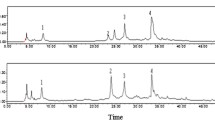Abstract
Purpurogallin (PPG) is a phenolic compound extracted from nutgalls formed on oak trees. It has been used as an additive to edible or nonedible oils or fats, and to hydrocarbon fuels or lubricants to retard their oxidation. We investigated by luminoldependent chemiluminescence (PMNL-CL), the ability of PPG to scavenge oxygen free radicals (OFRs) generated by zymosanactivated polympophonuclear leukocytes (PMNLs). Its OFR-scavenging ability was also investigated by the use of nitro blue tetrazolium (NBT). We also investigated by the dye-exclusion method, if PPG affects the viability of PMNLs. PPG in the concentrations of 0.005–0.4 mM was used in this study. PPG scavenged OFRs produced by zymosan-activated PMNLs in a concentration-dependent manner. Almost complete scavenging was observed at a concentration of 0.2 mM. The NBT test indicated that PPG (0.2 mM) did not completely prevent the activation of PMNLs by zymosan. Viability of PMNLs in the absence or presence of PPG (0.4 mM) were 95.77±0.56% and 96.78±0.60% respectively. The results suggest that PPG scavenges OFRs produced from activated PMNLs in a concentration-dependent manner and that the cell viability is not affected by PPG. PPG is a potent scavenger of OFRs and should be of value in the prevention and treatment of diseases in the pathophysiology of which OFRs are involved. (
Similar content being viewed by others
References
Claus EP: Pharmacognosy 3rd Edition, Lea and Febiger, Philadelphia, pp 231–233, 1965
Critchlow A, Haslam E, Haworth RD, Tinker PB, Waldron NM: The oxidation of some pyrogallol and purpurogallin derivatives. Tetrahedron 23: 2829–2847, 1967
Anderson WA: Hydroxylic aromatic compounds as additives for rubber based, composite solid propellants. US Patent 4181545 assigned to United Technologies Corporation, 1980
Wu TW, Wu J, Carey D, Zeng LH: Purpurogallin protects both ventricular myocytes and aortic endothelial cells of rats against oxyradical damage. Biochem Cell Biol 70: 803–809, 1992
Wu TW, Zeng LH, Wu J, Carey D: Purpurogallin—a natural and effective hepatoprotectorin vitro andin vivo. Biochem Cell Biol 69: 747–759, 1991
Sugiyama H, Fung KP, Wu TW: Purpurogallin as an antioxidant protector of human erythrocytes against lysis by peroxyl radicals. Life Sci 53: 39–43, 1993
Chenoweth DE, Cooper SW, Hugli T, Stewart RW, Blackstone EH, Kirklin JW: Complement activation during cardiopulmonary bypass. Evidence for generation of C3a and C5a anaphylatoxins. N Engl J Med 304: 497–503, 1981
Chiu RCJ, Samson R: Complement (C3, C4) consumption in cardiopulmonary bypass, cardioplegia and protamine administration. Ann Thorac Surg 37: 229–232, 1984
Kirklin JK, Westaby S, Blackstone EH, Kirklin JW, Chenoweth DE, Pacifico AD: Complement and damaging effects of cardiopulmonary bypass. J Thorac Cardiovasc Surg 86: 845–857, 1983
Craddock PR, Fehr J, Brigham KL, Kronenberg RS, Jacob HS: Complement and leukocyte-mediated pulmonary dysfunction in hemodialysis. N Engl J Med 296: 769–774, 1977
Lucchesi BR, Werns SW, Fantone JC: The role of the neutrophil and free radicals in ischemic myocardial injury. J Mol Cell Cardiol 21: 1241–1251, 1989
Granger DN: Role of xanthine oxidase and granulocytes in ischemia reperfusion injury. Am J PHysiol 255: H1269–1275, 1988
Engler RL, Dahlgren MD, Morris DD, Peterson MA, Schmid-Schonbern GW: Role of leukocytes in response to acute myocardial ischemia and reflow in dogs. Am J Physiol 251: H314–322, 1986
Fantone JC, Ward PA: Role of oxygen-derived radicals and metabolites in leukocytes-dependent inflammatory reactions. Am J Pathol 107: 397–417, 1982
Babior BM: The respiratory burst of phagocytes. J Clin Invest 73: 599–601, 1984
Prasad K, Chaudhary AK, Kalra J: Oxygen-derived free radicals producting activity and survival of activated polymorphonuclear leukocytes. J Mol Cell Biochem 103: 51–62, 1991
Harisson JE, Schultz J: Studies on chlorinating activity of myeloperoxidase. J Biol Chem 251: 1371–1374, 1976
Campbell AK, Holt ME, Patel A: Chemiluminescence in medical biochemistry. In: G.M.M. Ablertin and C.P. Price (eds). Recent Advances in Clinical Chemistry, Vol. III. Churchill Livingstone, Edinburgh, 1984, pp 1–30
English D, Andersen BR: Single-step separation of red blood cells, granulocytes and mononuclear leukocytes on discontinuous density gradients of Ficoll-Hypaque. J Immunol Methods 5: 249–52, 1974
Prasad K, Kalra J, Bharadwaj B, Chaudhary AK: Increased oxygen free radical activity in patients on cardiopuomonary bypass undergoing aortocoronary bypass surgery. Am Heart J 123: 37–45, 1992
Kato T, Wokalek H, Schöpf E, Eggert H, Ernst M, Rietchel ET, Fischer H: Measurement of chemiluminescence in freshly drawn human blood. Klin Wochencher 59: 203–211, 1981
Prasad K, Kalra J, Chaudhary AK, Debnath D: Effect of polymorphonuclear leukocyte-derived oxygen free radicals and hypochlorous acid on cardiac function and some biochemical parameters. Am Heart J 119: 538–550, 1990
Barroso-Aranda J, Schmid-Schönbein GW: Transformation of neutrophils as indicator of irreversibility in hemorrhagic shock. Am J Physiol 257: H846-H852, 1989
Zweier JL, Kuppusamy P, Lutty GA: Measurement of endothelial cell free radical generation: Evidence for a central mechanism of free radical injury in postischemic tissues. Proc Natl Acad Sci USA 85: 4046–4050, 1988
Park BH, Fikrig SM, Smithwick EM: Infection and nitroblue-tetrazolium reduction by neutrophils. Lancet 2: 532–534, 1968
Prasad K, Kalra J: Oxygen free radicals and hypercholesterolemic atherosclerosis: Effect of vitamin E. Am Heart J 125: 958–973, 1993
Holt ME, Ryall MET, Campbell AK: Albumin inhibits human polymorphonuclear leukocyte luminol-dependent chemiluminescence: Evidence for oxygen free radical scavenging. Brit J Exptl Pathol 65: 231–241, 1984
DeChatelet CR, Shirley PS: Evaluation of chronic granulomatous diseases by a chemiluminescent assay of microlitre quantities of whole blood. Clin Chem 27: 1739–1741, 1981
Tono-Oko T, Ueno N, Matsumoto T: Chemiluminescence of whole blood. I. A simple and rapid method for the estimation of phagocytic function of granulocytes and opsonic activity in whole blood. Clin Immunol Immunopathol 26: 66–75, 1993
Author information
Authors and Affiliations
Rights and permissions
About this article
Cite this article
Prasad, K., Kapoor, R. & Lee, P. Purpurogallin, a scavenger of polymorphonuclear leukocyte-derived oxyradicals. Mol Cell Biochem 139, 27–32 (1994). https://doi.org/10.1007/BF00944200
Received:
Accepted:
Issue Date:
DOI: https://doi.org/10.1007/BF00944200




